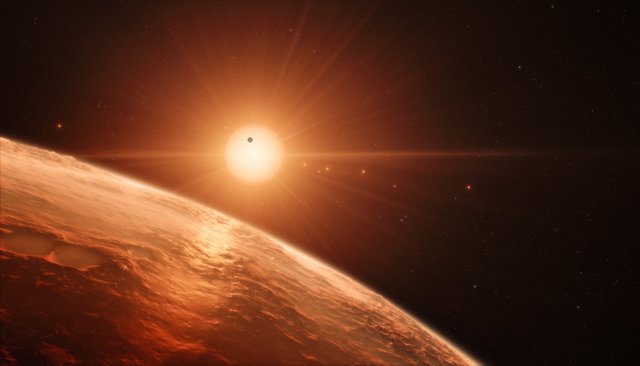
Almost a year after the announcement of the discovery of seven planets at the "right"distance of their star to be able to have liquid water, here in our cosmic neighborhood, the team of scientists who detected them returns with more news: confirms that they are all rocky, like the Earth, and that some may even have more water than our planet.
"The densities of the planets, now known much more accurately than before, suggest that some of these bodies can have as much as 5% of their mass in the form of water - about 250 times more than Earth's oceans," says one press release from the European Southern Observatory (ESO), an intergovernmental organization of astronomy (to which Portugal belongs) that has several telescopes in Chile, where these planets began to be detected.
The seven planets orbit a small star (only 8% of the mass of the Sun) and little hot, a cold dwarf, called Trappist-1 located "only" 40 light years away from Earth. Using a robotic telescope in Chile called Trappist-Sul (acronym for Transiting Planets and Planetesimals Small Telescope), the team began by announcing in 2016 that around the star Trappist-1 had been discovered three planets the size of the Earth.
Many telescopes then turned to Trappist-1 - from the Large Telescope Telescope (VLT) of ESO in Chile, and other ground-based telescopes to the NASA Spitzer Space Telescope. What they discovered was that Trappist-1 had, after all, seven planets of size similar to that of Earth around them Known as Trappist-1b, c, d, e, f, g, h, in increasing order of distance from their star, these planets were announced to the world in February 2017 as seven Earth sisters and aroused much interest. Now in scientific articles published in the journals Nature Astronomy and Astronomy & Astrophysics , the team coordinated by Michaël Gillon, University of Liège(Belgium), reports the results of both more observations on ground and space telescopes as well as complex computational models for more accurately determine the densities of the planets. "We have found that Trappist-1c and Trappist-1e probably have large rocky interiors, while planets b, d, f, g, h have volatile envelopes in the form of thick atmospheres of oceans or ice, fraction of water mass of less than 5%, "
"In terms of size, density and radiation received from the star, the fourth planet from the interior is the most similar to
Earth," says an ESO press release regarding Trappist-1e: "It seems to be the more rocky of the seven and has potential to have liquid water on its surface. "The fact that its composition looks more rocky than the others is still a mystery. But with similarities, Trappist-1e is not quite the same as Earth: in reality, it is slightly dense, suggesting that it may also have an iron core even denser than our planet. And having the capacity to have water does not mean, clarifies the ESO, that necessarily has something with the size of an ocean. Combining measurements of planetary densities with their computational models, scientists have concluded that the seven planets around the Trappist-1 star have much to fascinate us: "They seem to contain significant amounts of volatile materials, probably water, in some cases, to 5% of the planet's mass - a huge amount when compared to the Earth, which has only about 0.02% water relative to its mass. "

Even though it is at a "right" distance from the star in order to have liquid water (located in the habitable zone), even confirming that they are rocky and that some of them are probably rich in water, it remains unknown whether on the surface of these seven worlds there will be some form of life. "Despite this, our study is an important step in determining whether these planets can support life," said one of the authors, BriceOlivier Demory of the University of Bern, Switzerland, quoted in the statement. Among the other novelties, the scientists reveal that the planets Trappist-1b and
Trappist-1c (the two closest to the star) probably have rocky nuclei (such as the aforementioned Trappist-1e) and, in
addition, much thicker atmospheres of that of Earth. The planet Trappist-1d is more "light" than our planet, having about 30% of its mass.
Finally, the three planets farther from the star - the Trappist-1f, g, h - are already far enough away, so the water may be frozen to its surface. And if they have thin atmospheres, they probably do not contain the heavy molecules in the Earth's
atmosphere, such as carbon dioxide. "It is interesting to note that the denser planets are not those that are closest to the star and that the cooler planets can not contain dense atmospheres," summarizes Caroline Dorn, at the University of Zurich,Switzerland, also among the authors of the paper.
The next news coming from Trappist-1 is expected, in particular when ESO's Chilean Extremely Large Telescope is in action, and NASA's James Webb Space Telescope, both under construction. Maybe then we will know whether they have in fact atmospheres and what they are composed of.
Hi, I found some acronyms/abbreviations in this post. This is how they expand:
Downvoting a post can decrease pending rewards and make it less visible. Common reasons:
Submit